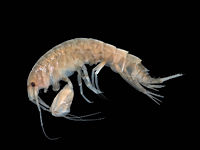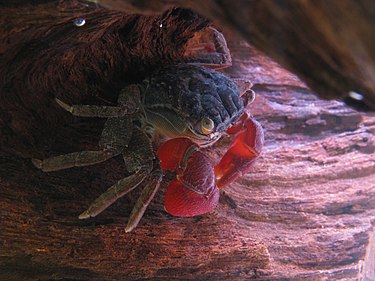Portal:Crustaceans
The Crustaceans Portal Crustaceans are a group of arthropods that are a part of the subphylum Crustacea (/krəˈsteɪʃə/), a large, diverse group of mainly aquatic arthropods including decapods (shrimps, prawns, crabs, lobsters and crayfish), seed shrimp, branchiopods, fish lice, krill, remipedes, isopods, barnacles, copepods, opossum shrimps, amphipods and mantis shrimp. The crustacean group can be treated as a subphylum under the clade Mandibulata. It is now well accepted that the hexapods (insects and entognathans) emerged deep in the Crustacean group, with the completed group referred to as Pancrustacea. The three classes Cephalocarida, Branchiopoda and Remipedia are more closely related to the hexapods than they are to any of the other crustaceans (oligostracans and multicrustaceans). The 67,000 described species range in size from Stygotantulus stocki at 0.1 mm (0.004 in), to the Japanese spider crab with a leg span of up to 3.8 m (12.5 ft) and a mass of 20 kg (44 lb). Like other arthropods, crustaceans have an exoskeleton, which they moult to grow. They are distinguished from other groups of arthropods, such as insects, myriapods and chelicerates, by the possession of biramous (two-parted) limbs, and by their larval forms, such as the nauplius stage of branchiopods and copepods. Most crustaceans are free-living aquatic animals, but some are terrestrial (e.g. woodlice, sandhoppers), some are parasitic (e.g. Rhizocephala, fish lice, tongue worms) and some are sessile (e.g. barnacles). The group has an extensive fossil record, reaching back to the Cambrian. More than 7.9 million tons of crustaceans per year are harvested by fishery or farming for human consumption, consisting mostly of shrimp and prawns. Krill and copepods are not as widely fished, but may be the animals with the greatest biomass on the planet, and form a vital part of the food chain. The scientific study of crustaceans is known as carcinology (alternatively, malacostracology, crustaceology or crustalogy), and a scientist who works in carcinology is a carcinologist. (Full article...) Selected article
Dyspanopeus sayi is a species of mud crab that is native to the Atlantic coast of North America. It has also become established outside its native range, living in Swansea Docks since 1960, the Mediterranean Sea since the 1970s, the North Sea since 2007 and the Black Sea since 2010. It can reach a carapace width of 20 mm (0.8 in), and has black tips to its unequal claws. It feeds on bivalves and barnacles, and is in turn eaten by predators including the Atlantic blue crab, Callinectes sapidus. Eggs are produced from spring to autumn, the offspring reach sexual maturity the following summer, and individuals can live for up to two years. The closest relative of D. sayi is D. texanus, which lives in the Gulf of Mexico; the two species differ in subtle features of the genitalia and the last pair of walking legs.
Did you know?
Selected biography
Mary J. Rathbun (1860–1943) was an American zoologist, specialising in crustaceans. She was born on June 11, 1860 in Buffalo, New York the youngest of five children. Her mother died when she was only one year old, and Mary was therefore "thrown on her own resources". She was schooled in Buffalo, graduating in 1878, but never attended college. Mary first saw the ocean in 1881 when she accompanied her brother, Richard Rathbun, to Woods Hole, Massachusetts. He was employed as a scientific assistant to Addison Emery Verrill, alongside Verrill's chief assistant, the carcinologist Sidney Irving Smith. Mary helped label, sort and record Smith's specimens, and worked on crustaceans ever since.
For three years, Mary worked on a voluntary basis for her brother, before being granted a clerkship by Spencer Fullerton Baird at the Smithsonian Institution. She continued to work at the museum, largely unaided, and after 28 years, she was promoted to assistant curator in charge of the Division of Crustacea. Her largest work was Les crabes d'eau douce ("Freshwater crabs"), published in three volumes in 1904–1906. She wrote or co-wrote 166 papers in total, including descriptions of 1147 new species and subspecies, 63 new genera, one subfamily, 3 families and a superfamily, as well as other nomenclatural novelties. The taxa first described by Rathbun include important commercial species such as the Atlantic blue crab Callinectes sapidus, and the tanner crab, Chionoecetes bairdi. She retired on the last day of 1914, but did not stop working until her death. She qualified for a Ph.D. at George Washington University in 1917. Selected image Perisesarma bidens is a semiterrestrial crab from tropical Asia. General imagesThe following are images from various crustacean-related articles on Wikipedia.
Crustacean lists
SubcategoriesRelated portalsWikiProjectsAssociated WikimediaThe following Wikimedia Foundation sister projects provide more on this subject:
Discover Wikipedia using portals
|






















































